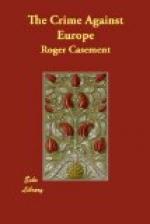Fray Mattheo de Oviedo, who had been sent to Ireland as Archbishop, wrote to King Philip III from O’Neill’s stronghold, Dungannon, on June 24, 1600. We might be listening to the voice of the Fortnightly Review of yesterday. “The English are making great efforts to bring about a peace, offering excellent terms, and for this purpose the Viceroy sent messengers twice to O’Neill, saying among other things, that Your Majesty is making peace with the Queen, and that his condition will be hopeless. At other times he says that no greater misfortune could happen to the country than to bring Spaniards into it, because they are haughty and vicious and they would destroy and ruin the country.” The Irish princes were no fools. “To all this they reply most honourably that they will hold out as long as they have one soldier or there remains a cow to eat.”
Hugh O’Neill saw clearly that all compromise between Ireland and England was futile, and that the way of escape was by complete separation and lay only through Europe. He again and again begged the Spanish King to sever Ireland and erect it into an allied State. He offered the crown of Ireland to a Spanish prince, just as three centuries earlier another and a great O’Neill offered the crown of Ireland to Edward Bruce in 1315.
The coming of the Bruce saved Gaelic Ireland for three centuries. Had Philip of Spain sent his son as King to Ireland, her fate had been settled then instead of remaining three centuries later to still confront European statesmanship with an unsolved problem.
In many letters addressed by the Irish leaders to Philip II and Philip III we find the constantly recurring note of warning that to leave England in possession of Ireland meant the downfall of Spain. The Irish princes knew that in fighting England they were in truth fighting the battle of European civilization.
Writing to Philip II from Lifford, on May 16th, 1596, O’Neill and O’Donnell drew the King’s attention to the cause of Ireland as the cause of Europe, and in the name of Ireland offered the crown to a Spanish prince. “But inasmuch as we have felt to our great and indescribably harm the evil doings and crimes of those whom the Queen of England is in the habit of sending amongst us, we beg and beseech Your Majesty to send someone well known to you and perfectly fit to be the King of this island, for his own welfare, ours, and that of the Christian State (Christendom).”
They asked for a prince “who will not be unwilling to rule over and live amongst us and to direct and guide our nation, well and wisely.” They pointed out how “he will obtain much advantage and glory by so doing,” and finally they begged “would that Your Majesty would appoint the Archduke of Austria, now Governor of Flanders, a famous man and worthy of all praise, than whom none would be more acceptable.” (The original is in Latin and in the archives of Simancas.)
No more statesmanlike appeal was ever made from Ireland; and had the Archduke of Austria assumed the crown of Ireland in 1596, “now or never” would indeed have become “now and forever.” Had Philip II carried out his often repeated promises of sending aid to that country the fate of his own kingdom must have been a very different one.




